
11 minute read
BACS and EPBD
BACS amendments in the revised EPBD The importance of proper, ambitious implementation
In this specially-commissioned article, Hans Smid, President, eu.bac – the voice of the European building automation sector – puts the revised EPBD into context, and especially so the changes with regard to BACS and the implementation of the “smart readiness indicator”.
Advertisement
Buildings account for almost 40% of the consumption of energy in the EU and the Energy Performance of Buildings Directive (EPBD) is the main legal instrument to address this challenge. It provides for a comprehensive and integrated approach towards improving the efficient use of energy in both new and existing buildings, residential as well as commercial. Ultimately, this is the instrument that translates high-level policy goals into concrete measures to deliver the expected savings in the building sector.
Being a Directive and not a Regulation, one key element that must be considered relates to the flexibility of the member states. A Directive always allows flexibility, to a certain extent, to the member states in the transposition of such a Directive. It is therefore essential not only to contribute to the legislative process at EU level, but also to support implementation at national level, to ensure there will be no loopholes undermining the achievement of the previouslyagreed goals.

Hans Smid, President, eu.bac
EPBD: what is it?
• The acronym EPBD stands for “Energy Performance of Buildings Directive” (2010/31/EU); • The Directive promotes policies helping: a) achieve a highly energy- efficient and decarbonised building stock by 2050; b) create a stable environment for investment decisions; c) enable consumers and businesses to make more informed choices to save energy and money; • The Directive was amended in 2018 (by the Directive 2018/844/EU) and will be amended again in the coming years (the Commission will present its new proposal in December 2021).
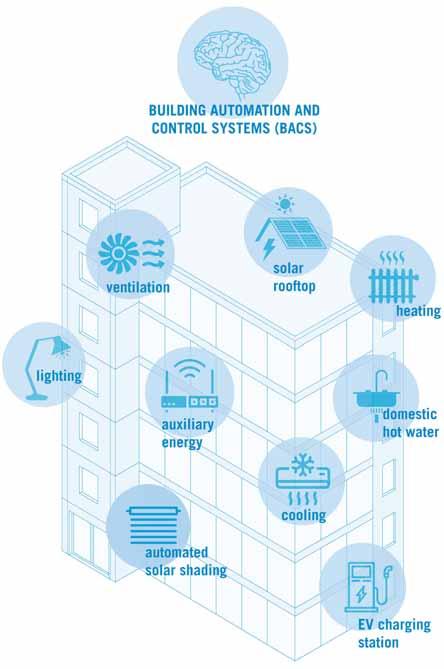

Figure 1 – Building automation and control systems (BACS).
The last revision of the EPBD was approved in 2018. The main changes, compared to the previous version of the Directive, were the strengthening of the long-term building renovation strategies and the introduction of measures to fully grasp the benefits of smart technologies, through a new smart readiness indicator and measures on building automation and control systems (BACS).
BACS refers to the products that monitor and automatically adjust the energy-using technologies in our homes and buildings to deliver a comfortable environment. They are, in a way, the “brain” of the building, as they ensure integration and optimal functioning of technical building systems, making sure they don’t work against each other and avoiding malfunctions.
BACS are also the “intelligent nodes” of the smart integrated energy system developed around


Directive or Regulation – what is the difference?
Both Directives and Regulations are different forms of legal acts of the EU. Other EU legal acts are Decisions, Recommendations and Opinions.
Regulation
An EU Regulation is immediately applicable and enforceable by law in all member states. As good practice, member states issue national legislation that defines the competent national authorities, inspection and sanctions on the subject matter.
Directive
A Directive is applicable to all member states. It sets certain aims, requirements and concrete results that must be achieved in every member state. It sets a process for it to be implemented by member states. National authorities must create or adapt their legislation to meet these aims by the date specified in each given Directive.
the building. Demand-response, consumption prediction, energy storage, management of distributed generation of renewables (e.g. solar roof-top PV) are all “smart functions” strongly connected to optimal functioning of the building. Thanks to them, building managers have real-time access to cloudbased analytics, reporting and services, allowing for informed decision-making. See Figure 1.
According to the new EPBD1, all non-residential buildings, existing and new, with an effective rated output > 290kW, must be equipped with certain BACS capabilities by 20252 .
These requirements are essential to achieve the EU climate goals and the figures prove this. These measures alone3 could lead to annual savings corresponding to 14% of the total building primary energy consumption with 36 billion energy bill savings triggered, and the value of energy savings exceeding the value of investments by a factor of 94. See Figure 2.
Nevertheless, these impressive numbers can be achieved only with an optimal implementation. How to achieve this? Here are two important elements.
First, the requirement for the deployment of the BACS capabilities is subject to a clause in the Directive: “where technically and economically feasible”. The Commission clarified5 that it is the duty of each single member state to transpose this requirement providing “clearly identified, framed and justified” parameters for defining feasibility. It is up to the single member state to decide which parameter and to set the threshold, but there should be a parameter.
The Commission also provides two examples that could be used in this framework – payback time or initial cost. France, for example, included a paragraph saying that the installation of BACS capabilities is always considered feasible unless the payback time is more than six years. In this specific case, when a building is in the scope of the requirement, in order not to have the capabilities there will be written proof that the payback time goes beyond six years. In the Dutch legislation, it is specifically written that the installation of BACS capabilities is always considered feasible.
Second, that the capabilities are defined in the Directive with simple words and no technical reference. In order to clearly distinguish which BACS are fulfilling the requirements from those which are not, there is the need to include more details by each member state. At eu.bac we first suggested to simply require the EN1523 Class B. As in some member states, it is not possible to make a direct reference to standards in the legislation and, as we were required to provide support on this, we developed the eu.bac EPBD BACS compliance verification checklist6. This checklist offers a highly-detailed tool for national compliance inspectors, building owners, BACS designers and policymakers. It helps industry professionals understand what systems need to be implemented, and helps authorities distinguish buildings that comply with EPBD BACS requirements from those that don’t. See Figure 3.
With the Directive entered into force in May 2018 and the deadline
BACS Compliance Verification Checklist
STEP 1: The BACS compliance verification shall be conducted only if the effective rated output for heating (Art.14)/air-conditioning (Art.15) systems or systems for combined space heating/air-conditioning and ventilation in the building is over 290kW.
ID SELF-DECLARATION COMPLIANCE QUESTIONS (answered by Building Owner) SELF-DECLARATION COMPLIANCE SUPPORTING RECORDS (provided by Building Owner)
PDF list of Heating system main equipment with indication of the maximum calorific output, expressed in kW, per piece of equipment COMPLIANCE VERIFICATION CHECKS (conducted by Building Inspector) (provided by Building Owner)
Check equipment nameplates of main Heating system equipment in main HVAC plant or the building Operation & Maintenance Manual
Check equipment nameplates of main Air-conditioning systems equipment in HVAC main plant or the building Operation & Maintenance Manual RESPONSE
<kW>
<kW> Boundary Conditions/ PREREQUISITES for the BACS capabilities to be effective
I
I1
I2 Information Section: 290 kW COVERAGE “What is the effective rated output (calorific output as per EPBD) of the Heating equipment in the building Heating systems (output of all heat generators in the building including main Heating equipment in plantrooms, e.g. boiler, solar heat system, CHP and heat-generating terminal equipment in rooms, e.g. electric direct heater)? NOTE: Every heat generator that adds heat to the building space regardless of its location (generation in main HVAC plant, distribution and emission in the room) should be added in the sum for the output.” “What is the effective rated output (calorific output as per EPBD) of the Air-conditioning systems in the building (output of all cold generators in the building including main cooling equipment in plantrooms, e.g. chiller, heat-pump, and cooling generating terminal equipment in rooms)? NOTE: Every cooling generator that adds cooling to the building space regardless of its location (generation in main plant, distribution and emission in the room) should be added in the sum for the output.” PDF list of Air conditioning system main equipment with indication of the maximum calorific output, expressed in kW, per piece of equipment
Figure 3 – BACS compliance verification checklist excerpt.
for transposition expired in March 2020, there can be no delay in fully implementing the EPBD. The delay in implementation has a negative effect on the environmental benefits expected from these alreadyapproved measures and is also creating an extremely unfair situation for investors and professionals – the first can end up spending money today on systems that will need to be replaced tomorrow, and the latter risk being overburdened with short-notice project requests when the 2025 deadline approaches.
At eu.bac, we want to live in a world where everyone lives in buildings that are smart, decarbonised and efficient. We work every day to make this a reality across the EU. Follow us on LinkedIn, Twitter and YouTube as @eubac and our website eubac.org for the future updates, news and events in the building automation and control sector.
References
1. Article 14 par. 4 and article 15 par. 5 (Directive amending the Energy Performance of Buildings Directive (2018/844/EU)). 2. The building automation and control systems shall be capable of: A. continuously monitoring, logging, analysing and allowing for adjusting energy usage; B. benchmarking the building’s energy efficiency, detecting losses in efficiency of technical building systems, and informing the person responsible for the facilities or technical building management about opportunities for energy efficiency improvement; C. allowing communication with connected technical building systems and other appliances inside the building, and being interoperable with technical building systems across different types of proprietary technologies, devices and manufacturers. 3. Together with the other key requirement of article 8, prescribing the mandatory installation of self-regulating devices for the control of the temperature in each room. 4. Additional relevant figures: 64 Mt CO2 annual savings (peak in 2030) and 450 TWh annual final energy savings (peak in 2035). 5. COMMISSION RECOMMENDATION (EU) 2019/1019 of 7 June 2019 on building modernisation (paragraph 2.3.4, page 23).

COMMERCIAL HEATING
Having signed a partnership agreement with Arbonia Group AG this time last year, Hevac has already gained considerable market share with their portfolio of high-quality, innovative commercial radiator, radiant panel and trench heating products.
Established in 1874 in Switzerland, the Arbonia Group has an annual turnover of circa 1.1 billion and is active in more than 70 countries worldwide. In Ireland, Hevac is promoting its full product portfolio under the Arbonia umbrella with a particular focus on the Decotherm and Arbotherm 1.5mm thick steel tubular commercial radiator products, radiant panels and tubes, and trench heating.
Design service
Today’s marketplace demands much more that just warmth … the heating system has to be energyefficient, it must comply with all relevant standards, offer long life, flexible siting and have modern aesthetics. That may be a tall order for some but the Hevac Arbonia partnership delivers to that exacting brief, thanks especially to the system design and product selection support provided by Hevac Sales and Specification Representative, Bernice Reid.
Bernice has extensive experience of quoting commercial heating projects, and is especially adept at receiving heatloss schedules from consultants and selecting the most suitable product(s) to meet the intended application. She is very comfortable doing site visits while consultants can also meet her at Hevac’s new purpose-designed showroom and training centre in Santry to discuss projects.

Bernice Reid
Decotherm
Decotherm is an award-winning classic radiator offering enhanced quality and optimised visual appearance. It represents straightforward, high-quality heating design and clear lines, and is the perfect complement to modern, sophisticated interior architectural settings. Decotherm is ideal for schools as these radiators meet the technical guidance document requirement of 1.5mm steel thickness. Shallow models are available for recesses (something that is especially important in many schools) while the 2mm steel highpressure version is designed for high office blocks, prisons etc.
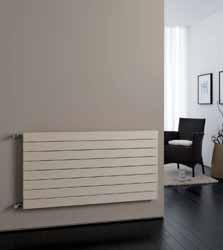
Arbotherm
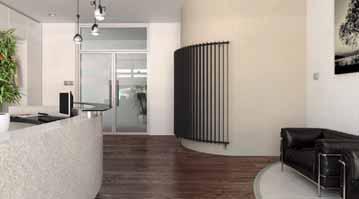
Arbotherm offers a clear flat-pipe structure and open transparency for an architecturallyoutstanding heating solution. All models are optimised to provide short reaction periods and an optimal proportion of radiated heat and convection. Extremely adaptable, Arbotherm models are especially effective in front of glazing, and as a parapet or stairway railing, with its softly-curved, angular design providing limitless options. There is also a double-layer version for even more heat.
Radiant Panels
The Arbonia range of radiant panels is suitable for installation into ceiling grids, plasterboard solutions or simply left free-hanging. They are available with anti-bacterial paint for hospital environments, something that is now an even more sought-after requirement. There are also larger industrial panels for high-bay warehouses, airports and school gymnasiums.
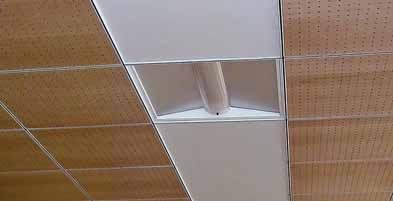
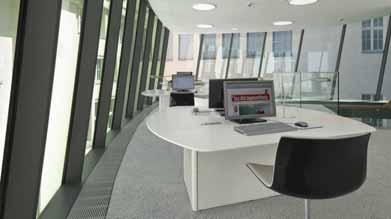
Trench Heaters
Arbonia trench heaters come in three types: • Natural convection • Fan-assisted • Heating and cooling There is also a range of Arbonia grilles incorporating special construction such as angular, around columns and mitred cuts.
Muirfield Drive, Naas Road, Unit 1, Furry Park Industrial Estate, South Ring West Business Park, Dublin 12. T: 01 – 419 1919. Dublin 9. T: 01 – 842 7037. Tramore Road, Cork. T: 021 – 432 1066.










